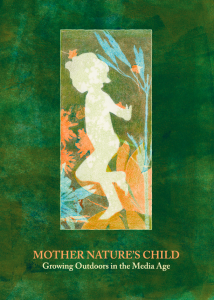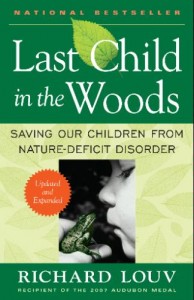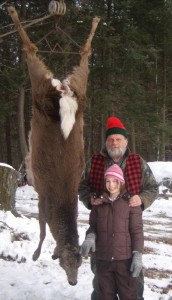 Even before the film started, my antennae were up.
Even before the film started, my antennae were up.
Cath and I had gone to the January 25th screening of Mother Nature’s Child: Growing Outdoors in the Media Age out of general curiosity. The documentary’s message would, I expected, be much like that presented by Richard Louv’s compelling book Last Child in the Woods.
In her brief remarks before the lights went down, however, filmmaker Camilla Rockwell had piqued a more specific interest. She said that certain parts of the film were “edgy.” She would be curious to hear how people felt about them.
What would be “edgy” in a documentary about connecting kids to nature?
My gut gave one answer: hunting.
 In Louv’s book, I recalled, several pages were devoted to “The Case for Fishing and Hunting.” Louv wrote that these activities “remain among the last ways that the young learn of the mystery and moral complexity of nature in a way that no videotape can convey.” As a non-hunting angler, though, his focus was on fishing. Hunting remained in the background.
In Louv’s book, I recalled, several pages were devoted to “The Case for Fishing and Hunting.” Louv wrote that these activities “remain among the last ways that the young learn of the mystery and moral complexity of nature in a way that no videotape can convey.” As a non-hunting angler, though, his focus was on fishing. Hunting remained in the background.
Settling into my seat, I enjoyed the first half of the film. It’s a well-crafted piece, blending footage of young people outdoors with excerpts from interviews with adults. We saw suburban kids running through the woods and crawling through hollow logs, their voices high with excitement. We saw urban teenagers planting gardens and learning to fly-fish. We heard from teachers, parents, and researchers.
Watching and listening, I was reminded just how crucial interaction with the natural world is for children’s physical, emotional, mental, and spiritual health. I wondered, not for the first time, who I would be today if I had not spent my boyhood summers almost entirely outdoors, wandering the woods, fishing for brook trout, catching tadpoles and bullfrogs.
And then, halfway through the film, there she was: a girl about ten years old, headed to the Vermont woods with her grandfather—in blaze orange.

Sitting there in the Montpelier’s independent theater, The Savoy, we watched the girl handling a rifle. We watched her waiting in the woods. We saw clips from interviews: Nancy Bell of The Conservation Fund talking about her respect for animals and why she hunts, Jon Young talking about how close contact with nature helps young people confront deep questions concerning life and death. Finally, we saw a still image of girl and grandfather. Beside them hung a dead deer: her first.
Fifteen years ago, I would have been horrified. Killing animals, I would have argued, has nothing to do with encouraging healthy relationships with nature, especially for kids.
Now, I see it differently. The filmmakers—both of them non-hunters—have given us a fine documentary about children’s relationships with the natural world. They have also given us a stereotype buster: women and girls hunt, and environmentalists, too! Perhaps most importantly, they have given us a great conversation starter.
The film opens a door for hunters and non-hunters to talk about hunting. Why do some of us hunt? What is it about hunting that others find revolting? Is it helpful to distinguish between stereotypes and first-hand experiences? Is it helpful for non-hunters to hear from actual hunters about how they relate to nature and animals? And, of course: What roles can or should hunting play in young people’s lives?
The film also opens a door for hunters and non-hunters to talk about our shared love of nature. It’s high time, after all, that conservationists—hunters, non-hunters, and anti-hunters—stopped lobbing political firebombs at each other.
It’s time we heeded the warning issued by Richard Nelson in his introduction to A Hunter’s Heart: “After we’ve lost a natural place, it’s gone for everyone—hikers, campers, boaters, bicyclists, animal watchers, fishers, hunters, and wildlife—a complete and absolutely democratic tragedy of emptiness.” Unless we work together, how can we insure that there will be natural places left for our children to relate to?
In the post-screening discussion, it so happens, not one person drew attention to the segment on hunting.
No, I take that back. One person did, indirectly. A man stood up to say that his young son, who appeared in the film, has now taken hunter safety and has put both squirrel and rabbit on the family dinner table. The father—a non-hunter (so far)—made it clear: connections with nature, including hunting, have done the boy nothing but good.
Notes: If you know of film festivals, schools, or outdoor education centers that might be interested in showing the film (or buying the DVD), please mention it to them. If you happen to live near any of these upcoming screenings, check it out in person:
- 3/17 – Vermont Institute of Natural Science, Quechee, VT
- 3/24 – CT Outdoor & Environ. Educ. Assn Conference, New Britain, CT
- 3/25 – Environmental Film Festival, Washington, DC
- 3/26 – Green Mountain Film Festival, Montpelier, VT
- 4/5 – Springfield Conservation Nature Center, Springfield, MO
- 5/18 – Shelburne Farms, Shelburne, VT
To learn more about Richard Louv’s work, visit the Children & Nature Network.
© 2011 Tovar Cerulli

Tovar, thanks for bringing this to our attention. I am buying the DVD and can’t wait to see the documentary. It is an excellent showcase for our community and industry.
You bet, Michelle! Glad to hear you’re getting a copy.
Awesome! I hope it comes west, and soon! Sounds like a good thing all around, and I’d definitely like to give it a look.
Hunting is entering a whole new world, with you adult-onset hunters, locavores, and the connection between environmentalism/conservation and hunting. I think I like it, but I wonder at the ways it’s going to change the face of the sport.
I hope you get a chance to see it, Phillip.
I do think hunting is changing. Then again, I’d argue that it has been in flux for five centuries of Euro-American history. It went through some particularly dramatic changes in the 1800s and early 1900s, when middle- and upper-class sport hunters wielded political force, lobbying for legislation that promoted both conservation and those hunters’ own ideals concerning what hunting should (and shouldn’t) be. It will be interesting to see how current changes unfold. I hope we can navigate the waters more gracefully than the urban “sport” and rural “pot” hunters of the late 1800s did!
P.S. Another thought, Phillip: In talking with the kinds of “new hunters” you refer to — in Maine and Vermont, for example, where I know a number of such folks — I hear a lot of respect for local, traditional hunting culture and a real concern for its survival.
It’s such a shame that this isn’t going to be anywhere near where I live; I would love to see the actual screening of it. Can an individual buy the DVD?
And this post/film gives me hope. I have already immersed my little daughter in the outdoors as much as I can – camping, fishing, sledding, etc. – and this gives me hope and helps to solidify that I’m leading her in the right direction, despite what some of my supposed “educator” co-workers seem to think.
Of course, in a few years, she’ll be out hunting with me as well. She needs to be well-rounded. 🙂
Hey, Arthur! From the film’s order page, it looks like anyone can order the DVD. The price for individuals (home use only) is a bit steep at $35. But it’s only $85 for a non-profit to buy it (they can do free public screenings). It’s $175 for a school or university (they can use it classrooms, libraries, etc).
Hope you and your daughter have a great time out there…
Amen!
I’d like to hear the conversations around the real thing most folks are afraid of when they think of kids and hunting, namely: kids and guns.
Yes, the firearm-safety issue is definitely part of it…
My 13 year old daughter has been bugging me about going out hunting with me for a few years. I talked to her about 2 weeks ago about what she needs to do to go this year. Of course, we’ll both be bow only. SHe has spent a lot of time with me taking outdoors classes and harvesting rabbits, so I’m sure she’ll be fine.
I hope you and your daughter have a great time out there, too, DEM.
I wonder what the audience would’ve thought if the hunting scenes had covered two 20-year-olds with deep Southern drawls.
I can imagine two things I would have thought: (1) Too bad this doesn’t challenge people to think past their stereotypes, and (2) What the heck does this have to do with children?
OK, LOL, should’ve made it a 14-year-old. There was a gap between when I read this and when I finally commented…
Getting kids out hunting and fishing is the goal of the Pass It On – Outdoor Mentors program. Working with youth mentoring organizations like Big Brothers Big Sisters, we recruit mentors who will share their time outdoors with a child.
We find that many of the children served by organizations like BBBS have few if any opportunities to experience the great outdoors we all know and love. We’ve met rural kids in Kansas who have never been on a dirt road, never seen a cow.
Seeing the excitement and joy they experience while hunting and fishing is truly remarkable. Boys, girls…it doesn’t matter. They all seem to relish the time they spend outdoors. And engaging in hunting and fishing seems to heighten the experience for them.
Mike Christensen
Pass It On – Outdoor Mentors, Inc.
http://www.outdoormentors.org
Thanks for the comment and the link to Outdoor Mentors, Mike. Glad to know of your work!
Glad I read this post. Sounds like another step in the right direction. Will try to catch this film in March, since there will be a screening very close to me in Ct.
I agree with Mike that it is truly remarkable how excited kids get when they are first exposed to fishing, hunting and related outdoor pursuits. This past Sept, I helped out at an event hosted by our State DEP Wildlife Division. The Dept put on a “Fishing and Hunting Appreciation Day” that was attended by over 1000 people, mostly families with school age children. The kids had a great timel!! They shot BB guns, learned to cast a fly, watched and participated in hunting retriever demos, learned to identify ducks and geese, blew duck calls, etc. Then they toured exhibits in a nature center that was funded by sportsmen’s contributions.
From my perspective, one of the best outcomes was the change in demeanor of the “non hunter” parents after watching the various demonstrations. For example, after watching their sons and daughters climb into a duck boat, or into a layout blind in front of a field goose rig, then blew a goose call, pop up and yell “bang” and watch our dogs make the retrieves, they started to loosen up. By the end of the 5 minute demonstration, many of the families started to ask detailed questions about hunting. These folks actually wanted to know more about decoys, guns, dogs, license requirements, how hunting is conducted and what’s required for kids to get involved.
To me, the next step is for more people to get involved in organizations like the one Mike mentions. There are plenty of kids who would be thrilled to join the hunters’ ranks, if they only had a mentor teach them about the outdoors.
I hope you do catch the film in CT, Dave.
It sounds like the DEP event was a blast. And I, too, would have been heartened by the shifts in the non-hunting parents’ demeanor and interest!
As I have been involved with governmental responsibilities toward wildlife management and policies for its protection and lawfull use lately, (the Vermont moose problem) I hope every citizen becomes an ardent sponsor of the North American Model of Wildlife conservation. Each hunter should know the seven sisters of wildlife management and play a role maintaining our vital national treasures through wise use. That our gov. understands its importance and remembers it belongs to all citizens and future generations. That we learn from our mistakes, and work to coexist within the natural system. The interconectedness of the web of life is demonstrated for us everyday if only we would take the time to watch. Women will be the salvation of hunting, they bring great attributes and qualities of openness, caring and compassion , plus restraint. This film sounds like good stuff! THanks for another great subject Tovar! The public trust coordinating groups work is a great example ! Got to keep an eye on your goverment. HUNT ON!
Exciting news. I have twin daughters that are six and a half, they are getting their first .22 this summer, a single-shot with a pink stock. It looks like a great “cross-over” film that bridges any divide between “consumptive” and “non-consumptive” outdoors people. I will have to find a way to see it or order it.
It sounds like you and your daughters enjoy your time outdoors together, Erik. That’s great!
“Cross-over” is a good label, yes. I hope you get to see the film.
I am involved with MN DNR outdoor mentor program, so I am going to call and see if they know about it. I’m thinking another angle is my children attend an urban environmental learning school, they may want to make use of it. As I’ve mentioned in the past, I am lucky to be in a very pro-hunting state, so even amongst urban people hunting isn’t that often a lightning rod. I expect there’s a lot of venues for this movie! It matches up with MN nice, the legal big game hunting age here is now ten, with direct adult supervision.